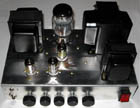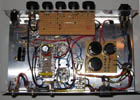
Tenere
Bass Amplifier – Class A low power
This is an amplifier for exercise, to play at home without deafening the neighbours and bothering the kids and the husband or wife: really 15W is
 peanuts for a bass.
peanuts for a bass. The project comes from a request of some bass-maniac friends asking for a very simple, easy-to-use, low power and low cost rig, but all-tube and Class-A (OK, low cost and all-tube don’t match, but I promised to do my best).
My first suggestion was an EL84 push-pull, but the guys were fond of HiFi-like sound and unequivocally they wanted a Class A topology, so the solution came by itself: if You need a bit of power in a rugged hardware (don’t forget that, despite the home use, the musicians generally use their instruments in a coarse way) at low cost the only solution is a SE Ultralinear with a KT88 (or 6550, or 6L6 if You can accept a little bit lower power).
KT88 is not an easy tube to drive, so the second half of a 12AX7 was good for a cathode follower, while the first half is good for the gain, and the
 schematic is easy and simple; no esoteric nor imagination, this is a bass guitar amplifier.
schematic is easy and simple; no esoteric nor imagination, this is a bass guitar amplifier.The preamplifier is not trivial: the easiest solution could be a twin stage – one 12AX7 ultrasimple schematic, You can find plenty on the web.
But if You are a good player (and my friend are) and You need a rig for exercise, You don’t need power but for sure You need performance and flexibility at a good level, not too much different from those of Your super-mega-trendy head, or it is useless.
So Gain, Bass – Mid – Treble (Marshall type) and Master Volume, high linearity and a FX Loop to process the signal as you like (if You like, of
 course), and switchable active/passive input.
course), and switchable active/passive input.The output of the FX Loop can be used for the tuner (first position in the effects chain).
No DI, just to keep it simple…. Uhm uhm, maybe next time.
Well, this is not a finished product, rather it is an experiment, something to test schematics and solutions, to be improved in the future, so the chassis is the most simple and economic.
Of course, to be used actually it must be inserted in some sort of box, You know, about 310V, high temperature, glass tubes… kids and cats around….
The Power Stage
The schematic is simple, but not too simple.
 I
choose automatic bias, a solution I’m not very fond of,
generally, just because it is simple and safe: no trimmers to
tweak (You can believe or not, but a trimmer is like a magnet for
people who don’t have any idea on how to tweak it).
I
choose automatic bias, a solution I’m not very fond of,
generally, just because it is simple and safe: no trimmers to
tweak (You can believe or not, but a trimmer is like a magnet for
people who don’t have any idea on how to tweak it).As I told, KT88 is driven by a cathode follower: 12AX7 perfectly fits to a music amplifier; would the destination be HiFi I would choose something stronger, a 6BM8 maybe, using the triode in the gain stage (it’s very similar to a 6SL7) and the pentode (triode connected) in the cathode follower, and I would use a better Output Transformer (hammond 1627 could be a good choice, but there are plenty).
You see a diode connected between the cathode and the grid of the cathode follower: it protects the cathode from stripping when the tube is cold and there is no current flow (that is for about 15 seconds when You switch on the power).
When the tube is cold voltage on the grid is about 300V and on the cathode is 0V: the electric field is very strong and can damage the surface of the cathode; the diode keeps the voltage between grid and cathode low until the tube is hot and current flows; in operating conditions the diode is reverse biased so it doesn’t affect the circuit.
RC coupling between stages is the simplest and safest, despite poor performances at clipping.
Overall performances are determined by the OPT: I choose a standard model available from the shelf in order to keep the cost low; it fits the destination of the amplifier (music).
Basic characteristics are: Primary Impedance 2300 – 2500 ohm, Ultralinear tap 43%, secondary impedances 8 ohm and 4 ohm.
NFB is mandatory because of the high plate resistance of the Beam Pentode (albeit in Ultralinear) and comes from 8ohm output.
Ultralinear topology gains a few watts compared with triode connection, with a higher THD, which is not a problem in a guitar / bass amplifier (maybe it is a bonus).
Preamplifier
We have three stages with low gain and high linearity because the cathode resistors are not bypassed.
 FX Loop allow the use of overdrive, distorsor and any other signal processor You like.
FX Loop allow the use of overdrive, distorsor and any other signal processor You like.FX Loop is before Tone Control, this is, IMHO, the right position, because any distortion device generates high harmonics and tone control can be very effective on sound only if it can manage all these harmonics: would the tone control be before, the harmonics generated would thwart the effect of the control.
The best solution would be having two (better, three) independent channels selected by footswitch, with different linearity, one clean and the other(s) overdrive (or distorted), each one with its own tone stack and Master Volume, and perhaps with switchable cut-off frequencies in the tone stack and… but this wants to be a simple project; maybe next project….
First stage is a gain stage with level and impedance adapter to drive the FX Loop: output impedance is 20kohm or so, and output level (nominal) is 0 dBV, suitable to any foot or rack effect.
Active or Passive input is selected via a switch, I see a nonsense in using two inputs when only one at a time is used.
Second stage is biased to have a very low gain (less than 20 dB), just enough to drive the tone stack (Marshall tone looses about 18 dB, Fender more than 20 dB).
After the tone stack there is the Master Volume that drives a low output impedance gain stage (a cathode follower driven by a grounded cathode): it can supply a signal strong enough to drive about any power amplifier.
As above, the diode to protect the cathode of the follower.
The Power Supply
It is the most classic and simple schematic, I would say trivial.
The choke is mandatory because SE output stages have a low PSRR and need a very clean high voltage.
Center tap of the heaters winding is connected to the cathode of the KT88, that is at 25V; this helps to lower the voltage between heater and cathode of the followers and improves the S/N ratio of the gain stages.
|
|
|||
| Home | Projects | ||